Nermin Samet
LOSC: LiDAR Open-voc Segmentation Consolidator
Jul 10, 2025Abstract:We study the use of image-based Vision-Language Models (VLMs) for open-vocabulary segmentation of lidar scans in driving settings. Classically, image semantics can be back-projected onto 3D point clouds. Yet, resulting point labels are noisy and sparse. We consolidate these labels to enforce both spatio-temporal consistency and robustness to image-level augmentations. We then train a 3D network based on these refined labels. This simple method, called LOSC, outperforms the SOTA of zero-shot open-vocabulary semantic and panoptic segmentation on both nuScenes and SemanticKITTI, with significant margins.
LOGen: Toward Lidar Object Generation by Point Diffusion
Dec 10, 2024



Abstract:A common strategy to improve lidar segmentation results on rare semantic classes consists of pasting objects from one lidar scene into another. While this augments the quantity of instances seen at training time and varies their context, the instances fundamentally remain the same. In this work, we explore how to enhance instance diversity using a lidar object generator. We introduce a novel diffusion-based method to produce lidar point clouds of dataset objects, including reflectance, and with an extensive control of the generation via conditioning information. Our experiments on nuScenes show the quality of our object generations measured with new 3D metrics developed to suit lidar objects.
MILAN: Milli-Annotations for Lidar Semantic Segmentation
Jul 22, 2024



Abstract:Annotating lidar point clouds for autonomous driving is a notoriously expensive and time-consuming task. In this work, we show that the quality of recent self-supervised lidar scan representations allows a great reduction of the annotation cost. Our method has two main steps. First, we show that self-supervised representations allow a simple and direct selection of highly informative lidar scans to annotate: training a network on these selected scans leads to much better results than a random selection of scans and, more interestingly, to results on par with selections made by SOTA active learning methods. In a second step, we leverage the same self-supervised representations to cluster points in our selected scans. Asking the annotator to classify each cluster, with a single click per cluster, then permits us to close the gap with fully-annotated training sets, while only requiring one thousandth of the point labels.
PAFUSE: Part-based Diffusion for 3D Whole-Body Pose Estimation
Jul 14, 2024Abstract:We introduce a novel approach for 3D whole-body pose estimation, addressing the challenge of scale- and deformability- variance across body parts brought by the challenge of extending the 17 major joints on the human body to fine-grained keypoints on the face and hands. In addition to addressing the challenge of exploiting motion in unevenly sampled data, we combine stable diffusion to a hierarchical part representation which predicts the relative locations of fine-grained keypoints within each part (e.g., face) with respect to the part's local reference frame. On the H3WB dataset, our method greatly outperforms the current state of the art, which fails to exploit the temporal information. We also show considerable improvements compared to other spatiotemporal 3D human-pose estimation approaches that fail to account for the body part specificities. Code is available at https://github.com/valeoai/PAFUSE.
Valeo4Cast: A Modular Approach to End-to-End Forecasting
Jun 12, 2024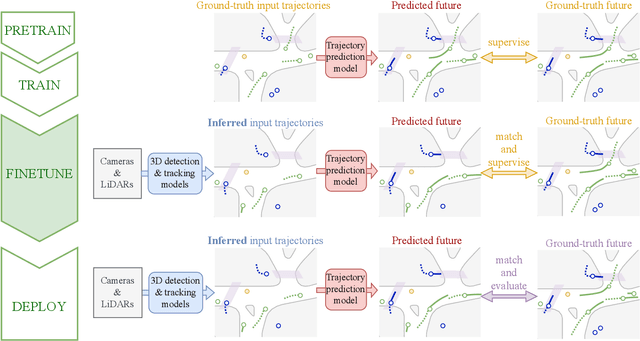
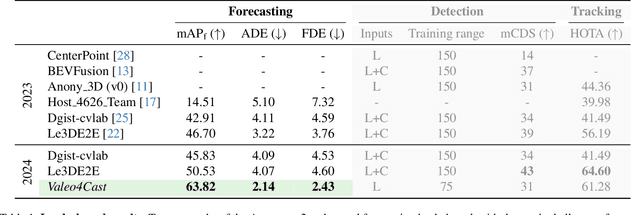
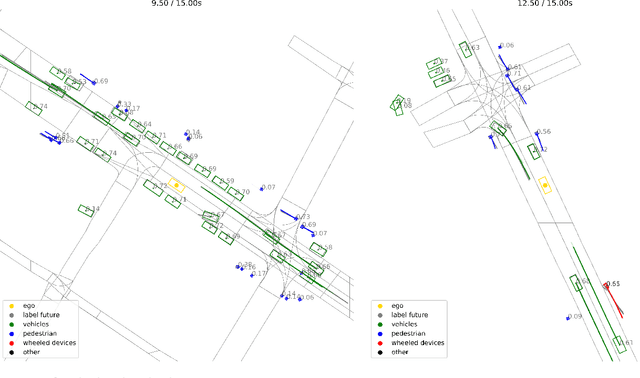
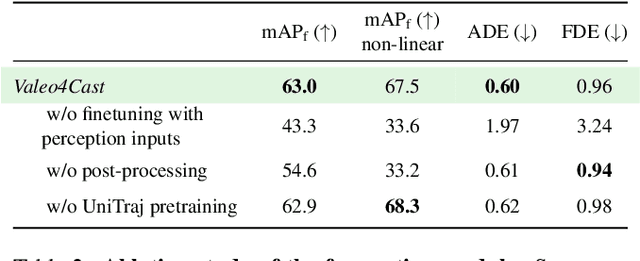
Abstract:Motion forecasting is crucial in autonomous driving systems to anticipate the future trajectories of surrounding agents such as pedestrians, vehicles, and traffic signals. In end-to-end forecasting, the model must jointly detect from sensor data (cameras or LiDARs) the position and past trajectories of the different elements of the scene and predict their future location. We depart from the current trend of tackling this task via end-to-end training from perception to forecasting and we use a modular approach instead. Following a recent study, we individually build and train detection, tracking, and forecasting modules. We then only use consecutive finetuning steps to integrate the modules better and alleviate compounding errors. Our study reveals that this simple yet effective approach significantly improves performance on the end-to-end forecasting benchmark. Consequently, our solution ranks first in the Argoverse 2 end-to-end Forecasting Challenge held at CVPR 2024 Workshop on Autonomous Driving (WAD), with 63.82 mAPf. We surpass forecasting results by +17.1 points over last year's winner and by +13.3 points over this year's runner-up. This remarkable performance in forecasting can be explained by our modular paradigm, which integrates finetuning strategies and significantly outperforms the end-to-end-trained counterparts.
ManiPose: Manifold-Constrained Multi-Hypothesis 3D Human Pose Estimation
Dec 11, 2023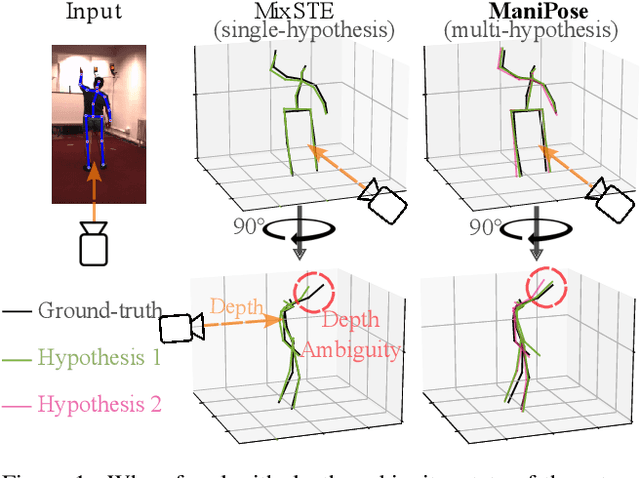
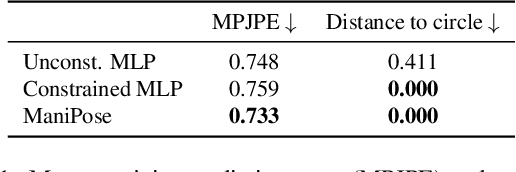
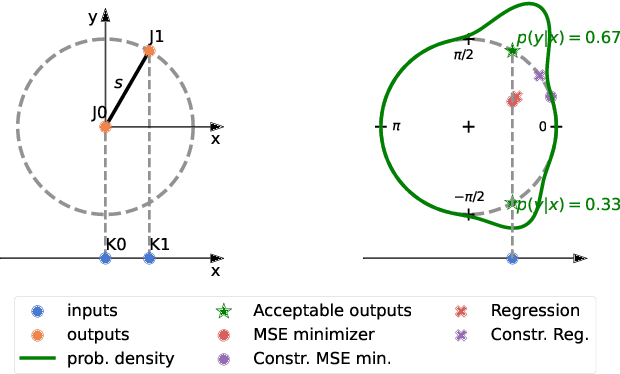
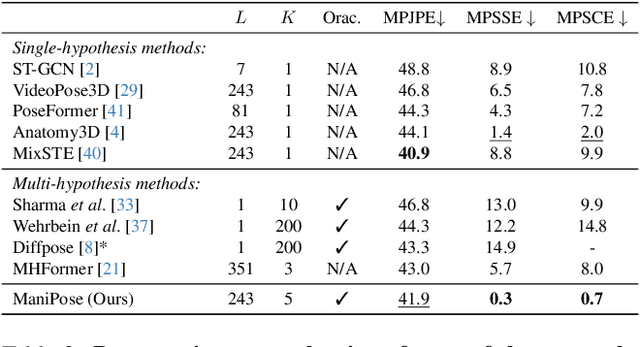
Abstract:Monocular 3D human pose estimation (3D-HPE) is an inherently ambiguous task, as a 2D pose in an image might originate from different possible 3D poses. Yet, most 3D-HPE methods rely on regression models, which assume a one-to-one mapping between inputs and outputs. In this work, we provide theoretical and empirical evidence that, because of this ambiguity, common regression models are bound to predict topologically inconsistent poses, and that traditional evaluation metrics, such as the MPJPE, P-MPJPE and PCK, are insufficient to assess this aspect. As a solution, we propose ManiPose, a novel manifold-constrained multi-hypothesis model capable of proposing multiple candidate 3D poses for each 2D input, together with their corresponding plausibility. Unlike previous multi-hypothesis approaches, our solution is completely supervised and does not rely on complex generative models, thus greatly facilitating its training and usage. Furthermore, by constraining our model to lie within the human pose manifold, we can guarantee the consistency of all hypothetical poses predicted with our approach, which was not possible in previous works. We illustrate the usefulness of ManiPose in a synthetic 1D-to-2D lifting setting and demonstrate on real-world datasets that it outperforms state-of-the-art models in pose consistency by a large margin, while still reaching competitive MPJPE performance.
WAIT: Feature Warping for Animation to Illustration video Translation using GANs
Oct 07, 2023Abstract:In this paper, we explore a new domain for video-to-video translation. Motivated by the availability of animation movies that are adopted from illustrated books for children, we aim to stylize these videos with the style of the original illustrations. Current state-of-the-art video-to-video translation models rely on having a video sequence or a single style image to stylize an input video. We introduce a new problem for video stylizing where an unordered set of images are used. This is a challenging task for two reasons: i) we do not have the advantage of temporal consistency as in video sequences; ii) it is more difficult to obtain consistent styles for video frames from a set of unordered images compared to using a single image. Most of the video-to-video translation methods are built on an image-to-image translation model, and integrate additional networks such as optical flow, or temporal predictors to capture temporal relations. These additional networks make the model training and inference complicated and slow down the process. To ensure temporal coherency in video-to-video style transfer, we propose a new generator network with feature warping layers which overcomes the limitations of the previous methods. We show the effectiveness of our method on three datasets both qualitatively and quantitatively. Code and pretrained models are available at https://github.com/giddyyupp/wait.
You Never Get a Second Chance To Make a Good First Impression: Seeding Active Learning for 3D Semantic Segmentation
Apr 23, 2023Abstract:We propose SeedAL, a method to seed active learning for efficient annotation of 3D point clouds for semantic segmentation. Active Learning (AL) iteratively selects relevant data fractions to annotate within a given budget, but requires a first fraction of the dataset (a 'seed') to be already annotated to estimate the benefit of annotating other data fractions. We first show that the choice of the seed can significantly affect the performance of many AL methods. We then propose a method for automatically constructing a seed that will ensure good performance for AL. Assuming that images of the point clouds are available, which is common, our method relies on powerful unsupervised image features to measure the diversity of the point clouds. It selects the point clouds for the seed by optimizing the diversity under an annotation budget, which can be done by solving a linear optimization problem. Our experiments demonstrate the effectiveness of our approach compared to random seeding and existing methods on both the S3DIS and SemanticKitti datasets. Code is available at \url{https://github.com/nerminsamet/seedal}.
Improving Sketch Colorization using Adversarial Segmentation Consistency
Jan 20, 2023Abstract:We propose a new method for producing color images from sketches. Current solutions in sketch colorization either necessitate additional user instruction or are restricted to the "paired" translation strategy. We leverage semantic image segmentation from a general-purpose panoptic segmentation network to generate an additional adversarial loss function. The proposed loss function is compatible with any GAN model. Our method is not restricted to datasets with segmentation labels and can be applied to unpaired translation tasks as well. Using qualitative, and quantitative analysis, and based on a user study, we demonstrate the efficacy of our method on four distinct image datasets. On the FID metric, our model improves the baseline by up to 35 points. Our code, pretrained models, scripts to produce newly introduced datasets and corresponding sketch images are available at https://github.com/giddyyupp/AdvSegLoss.
H3WB: Human3.6M 3D WholeBody Dataset and Benchmark
Nov 28, 2022



Abstract:3D human whole-body pose estimation aims to localize precise 3D keypoints on the entire human body, including the face, hands, body, and feet. Due to the lack of a large-scale fully annotated 3D whole-body dataset, a common approach has been to train several deep networks separately on datasets dedicated to specific body parts, and combine them during inference. This approach suffers from complex training and inference pipelines because of the different biases in each dataset used. It also lacks a common benchmark which makes it difficult to compare different methods. To address these issues, we introduce Human3.6M 3D WholeBody (H3WB) which provides whole-body annotations for the Human3.6M dataset using the COCO Wholebody layout. H3WB is a large scale dataset with 133 whole-body keypoint annotations on 100K images, made possible by our new multi-view pipeline. Along with H3WB, we propose 3 tasks: i) 3D whole-body pose lifting from 2D complete whole-body pose, ii) 3D whole-body pose lifting from 2D incomplete whole-body pose, iii) 3D whole-body pose estimation from a single RGB image. We also report several baselines from popular methods for these tasks. The dataset is publicly available at \url{https://github.com/wholebody3d/wholebody3d}.
 Add to Chrome
Add to Chrome Add to Firefox
Add to Firefox Add to Edge
Add to Edge